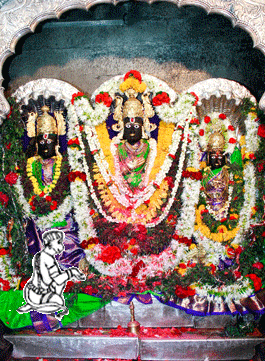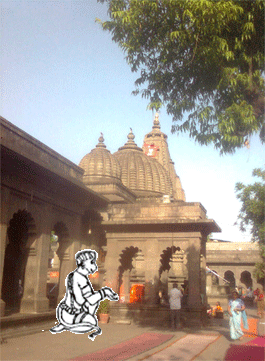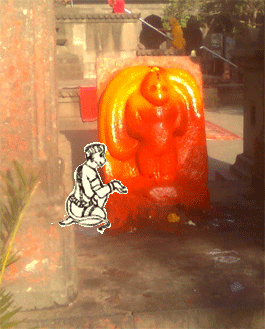
Nashik [Nasik]
Nashik [Nasik] an excellent and sanctified place is on the western edge of the Deccan peninsula and is surrounded by the Western Ghats making it picturesque and pleasant. The city is just 185 Km from Mumbai. The town is on the banks of the Godavari River originating from a nearby place called Trimbakeshwar. The climate of the town is delightful, and staying here will bring peace to the mind. The Kumbha mela festival held once every twelve years in this city makes this city a sanctified city and a holy place. This city gets its name Nashik after the event in epic Ramayana which took place in Panchavati. During the exile of Rama, Surpanakha the sister of the Ravana tried to seduce Rama. Angered, Rama ordered Lakshmana to cut off Shoorpanakha's nose (nasika).
Panchavati
 The city on the northern part of the river Godavari is called Panchavati. This place
gets its name Panchavati because a group of five banyan trees are seen together,
pancha is Sanskrit five and vat means banyan tree, hence Panchavati. It is seen from
Sri Valmiki Ramayan that Sri Rama had visited Agastya Rishi just after varsha ruthu
of his thirteenth year of exile and during sarath ruthu settled in Panchavati.
Lakshmana constructs a hut with wood and grass for Sri Rama’s stay at Panchavati. It
is the place where the event of cutting off the nose of Surpanakha took place.
The city on the northern part of the river Godavari is called Panchavati. This place
gets its name Panchavati because a group of five banyan trees are seen together,
pancha is Sanskrit five and vat means banyan tree, hence Panchavati. It is seen from
Sri Valmiki Ramayan that Sri Rama had visited Agastya Rishi just after varsha ruthu
of his thirteenth year of exile and during sarath ruthu settled in Panchavati.
Lakshmana constructs a hut with wood and grass for Sri Rama’s stay at Panchavati. It
is the place where the event of cutting off the nose of Surpanakha took place.
Akhadas
There are different sects of sadhus whose dwelling places are known as ‘Akhada’. Each akhadas has its own set of rules and regulations which the sadhus follow very strictly. Sri Niranjani, Sri Junadatta (Bhairav), Sri Mahanirvani, Sri Avahana, Sri Pancha Agni, Sri Nathpanthi Gorakhnath, Sri Vaishnav Bairagi, Sri Nagpanthi are the names of the few Akhadas.
Kumbh Mela
Kumbh Mela is a festival held in the holy places on the banks of the Holy Rivers and occurs once every twelve years. The main function is bathing in the Holy River at the appointed time. The sadhus of the Akhadas attend the Kumbh Mela held at different places in Bharat and take a holy bath in the river in the predetermined sequence. During the festival, preference is given to the Sadhus to take a bath over the others. In Maharastra, there are two places where Kumbh Melas are held Trimbakeshwar and Nashik.
Nagpanthi Sadhus and Sri Rama
Long ago ancestors of Sri Nagpanthi Sadhus were camping on the banks of river Godavari in the holy place of Panchavati. While bathing in the river Godavari they chanced upon the sculpture of Sri Rama, Sri Sita, and Sri Lakshman from the river. The place from where the Sri Rama statue was taken is now known as Ram Kunt. The sculptures of these deities were so exquisite that the Sadhus were mesmerised. Since the Sculpturer of this murthis is unknown and the Lord Himself had wished to come to Panchavati the deities were considered as ‘Swaim prakat’ or ‘Swamimbhu’.
Mandir for Sri Rama
The Sadhus then built a ‘paranasala’ [a dwelling made of wood and grass] exclusively for Sri Rama, Sri Sita, and Sri Lakshmana. This made the hut an excellent mandir for their deities. Daily poojas were conducted according to their norms and customs. The superb beauty of these deities made a wave in the minds of the people who visit the mandir and the fame of Sri Rama started spreading in the region.
Sardar Sri Odhekar
Later the region of Nasik came under the rule of Peshwas. Sri Ram Mandir of Panchvati drew the attention of Sri Gopikabai mother of Sri Madhava Rao Peshwa. She thought that a suitable temple should be built for these exquisite deities during her lifetime. Accordingly, she called the chief of the army Sardar Sri Ranga Raoji Odhekar, and asked him to make suitable arrangements for building a wonderful temple for Sri Rama. On the same night, Odhekar had a dream in which there was a divine direction to build the temple at the same place. He took it as a good omen and an order from Sri Rama. He vowed to construct the best possible temple at the same sanctified place.
Long ago while taking a bath in the river Godavari ancestors of Sri Nagpanthi Sadhus chanced upon the sculpture of Sri Rama, Sri Sita, and Sri Lakshman from the river. The sculptures of these deities were so exquisite that the Sadhus were mesmerised. Since the Sculpturer of this murthis is unknown and the Lord Himself had wished to come to Panchavati, the deities were considered as ‘Swaim prakat’ or ‘Swamimbhu’.
Conditions laid by Nagpanthis
As a first step for building the temple Sardar Sri Odhekar approached the Nagpanthis to help him realise the dream of constructing a new temple for Sri Rama. The Nagpanthis agreed to leave the holy place to build a new temple under certain conditions. Firstly they should be given an alternative place to dwell. Secondly, the Paduka of Sri Dutt Maharaj under the peepal tree and Sri Maruti murti should not be disturbed from the place. Thirdly the murti of Sri Ganesh in the south should not be displaced from that place. Fourthly the dharmsalas in the complex of the new temple will be left for the use of Nagpanthis during the Kumbh Mela time. Sardar Sri Odhekar agreed to all the conditions laid by Nagpanthis. It is to be noted that the dharmsalas around the temple are vacated for the use of Nagpanthi sadhus during Kumbh Mela.
Temple construction
Sardar Odhekar started the work of constructing a huge temple for Sri Rama and His parivar in the year 1778. He could complete the temple as late as 1790, it took almost twelve years to complete this mammoth all-stone temple. The hard black stones used in the construction of the temple were brought from Ramshej hills which is about 20 Km from the temple. The total cost worked out to be Rupees twenty-three lakhs. It is said that when the funds were not coming from the royal treasury Odhekar used to put in their own money for the construction of the temple. When there was a shortage of money for the purchase of gold-plated kalash his wife came forward to sell her diamond nose wear called ‘nathni’. Odhekar’s commitment to the construction of the temple for Sri Rama is enormous. Since Sri Rama had ordained him to build the temple at the very same place, Odhekar took all possible steps to complete the temple in a befitting manner for Sri Rama to dwell.
During construction of the temple
While it took twelve years for the completion of the temple, the murtis of Sri Rama, Sri Sita, and Sri Lakshmana were kept near the present western entrance under the care of Dikshits. They were performing the daily poojas for these deities. After completion of the temple, these deities were to be taken inside the sanctum sanctorum of the temple. Therefore Sri Ganesh vigraha was installed near the western entrance where Sri Rama had stayed for twelve years. But when the deities were to be shifted inside the temple from the western entrance, they refused to budge an inch from their seat. Odhekar then brought the great saintly man of the time Sri Timyyaabuaa Gosaavi of Sri Balaji mandir to help them. The holy man came and touched the deities with his ‘dhand’ [a wooden stick of the sanyasi] and to the astonishment of all, the movement of deities to the sanctum sanctorum inside the temple was smooth. From that time onwards the wooden stick is kept beside Sri Rama vigraha. Even today one can see the wooden stick wrapped in silver cover beside the main murthi.
The temple complex
 There are four entrances to the temple complex. As one enters the temple from the
eastern gate one can see that the entire complex is surrounded by an arched portal
verandah on all sides. The first thing one can see is a big hall supported by many
pillars where devotees are sitting and singing kirtans and bhajans in
praise of the Lord. The hall may be around seventy by thirty feet. The
kirtans from this hall can be heard in the main sanctum sanctorum. There is a
statue of Sri Maruti in an enclosure in a standing position at the eastern end of
the hall facing the main sanctum sanctorum. One can notice that the eyes of this Das
Maruti are in a straight line with the lotus feet of the Lord Sri Rama in the
sanctum sanctorum. ‘Surrender yourself to the lotus feet of the Lord to gain entry
into the heart of the Lord’ signifies Das Maruti.
There are four entrances to the temple complex. As one enters the temple from the
eastern gate one can see that the entire complex is surrounded by an arched portal
verandah on all sides. The first thing one can see is a big hall supported by many
pillars where devotees are sitting and singing kirtans and bhajans in
praise of the Lord. The hall may be around seventy by thirty feet. The
kirtans from this hall can be heard in the main sanctum sanctorum. There is a
statue of Sri Maruti in an enclosure in a standing position at the eastern end of
the hall facing the main sanctum sanctorum. One can notice that the eyes of this Das
Maruti are in a straight line with the lotus feet of the Lord Sri Rama in the
sanctum sanctorum. ‘Surrender yourself to the lotus feet of the Lord to gain entry
into the heart of the Lord’ signifies Das Maruti.
As one steps out of this hall onto the right side there is another small mandap with arched pillars. Here there is a statue of Sri Maruti in a standing position facing the east. This Maruti is known by the name Sharminda Maruti.
Then the main Sri Rama Mandir is seen. One has to step through the fourteen steps to enter the main temple. These fourteen steps signify the fourteen years of vana vasa Sri Ramachandra had. As we step up in these steps we surrender ourselves to the Lord and we can see the main deities from the distance. The eighty-foot distance now is nothing as we focus on the deities and their lotus feet. We get the immense pleasure of being near them in Panchavati.
Sri Rama parivar at Panchavati
All the three deities are seen in the black stone. Since Sri Rama is seen in black stone He is known as Kala Rama [kala in Hindi and Marathi means black]. Sri Rama here is in a unique posture, Lord is seen without a bow and arrow. Lord's right hand is seen on his left chest and the left hand shows His lotus feet in ‘dharjani’ mudra. Devotee has to surrender to the Lord's lotus feet and he will find a place in the heart of the Lord. Lord Sri Rama is flanked by Sri Sita and Sri Lakshmana on both sides.
Parikrama of the temple
After having darshan of Sri Rama, Sri Sita, and Sri Lakshmana as one comes out of the sanctum sanctorum through the southern entrance, one can see Sri Ganpathi mandir established by the Nagpanthis in the southwestern corner of the temple. After offering prayer at this sannidhi one can see Sri Ganpathi mandir near the western entrance. Offer your prayers to the Lord Sri Ganpathi here. Turn to north prakara and after a short distance, one can see peepal trees lined up. Under the first peepal tree, one can see the footprint of Sri Dutt Maharaj. Offer prayers to Sri Dutt Maharaj at his lotus feet.
Sri Maruti in the small mandap
 Moving further in the northern prakara one comes across a small mandap
with arched pillars. Here there is a statue of Sri Maruti in a standing position
facing the east. This Maruti is known by the name Sharminda Maruti. This is
the same mandap we have seen just before entering the main Sri Ram Mandir.
Moving further in the northern prakara one comes across a small mandap
with arched pillars. Here there is a statue of Sri Maruti in a standing position
facing the east. This Maruti is known by the name Sharminda Maruti. This is
the same mandap we have seen just before entering the main Sri Ram Mandir.
There is an interesting annotation as to why Sri Maruti is called Sharminda Maruti. This is the Sri Maruti statue and the footprint of Sri Dutt Maharaj which Nagpanthis told not to disturb while the new mandir for Sri Rama was being built.
Legand
Sri Rama’s presence at this mandir is confirmed by the fact that Sri Rama used to have discussions on Veda and dharma with Sri Dutt Maharaj who used to meditate under the ‘oudumber’ [peepal] tree. It is the same tree under which the footprint [paduka] of Sri Duttmaharaj is seen even today in the northern prakara of Mandir. This place is considered to be older than Kala Ram Mandir. It is said that during their discussion, Sri Hanumanji had entered the place. When Sri Hanumanji saw that his Lord was in a deep conversation with Sri Dutt Maharaji, he felt embarrassed. He felt that he should not have disturbed them and their discussion. He walked shying away from the place. Even today one can see Lord Hanumanji’s vigraha there, who is shying and his head is seen downward because of the embarrassment he had caused to his Lord. It is also worth noting that there is no gadha or any other weapon in his hand. That is why this Maruti is known by the name ‘Sharminda Maruti’.
Location of the temple: "Sri Kala Ram Mandir, Nasik, Maharastra"
Experience
Come visit Sri Kala Ram Mandir where Sri Das Maruti and Sri Sharminda Maruti are seen fully armed with ‘Sri Rama nama’ to protect you and take you nearer to Sri Rama.
SRI HANUMAN THINKS DIFFERENTLY, THINKS FAST
THINKS AHEAD AND ACTS FOR SURE
Ed [September 2012]
Updates: [Jan 2025]
